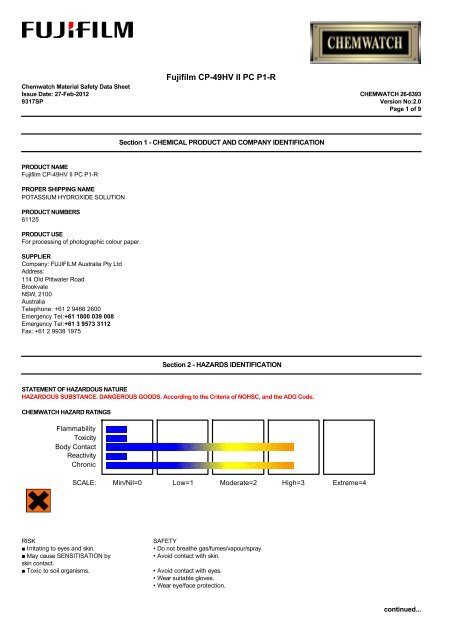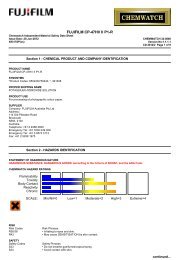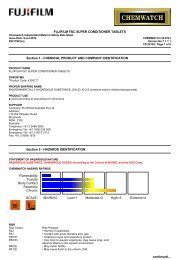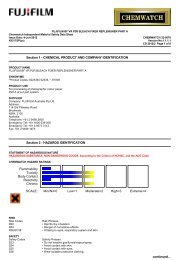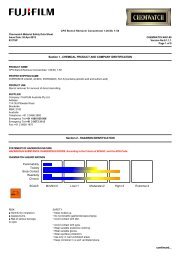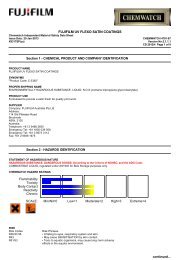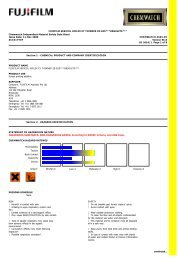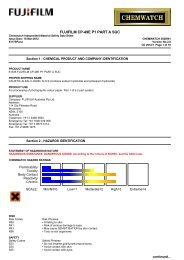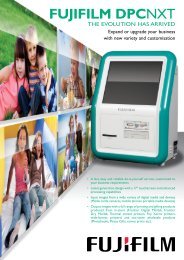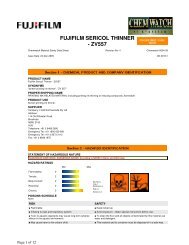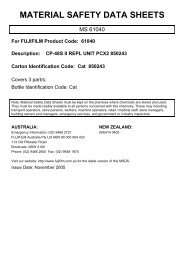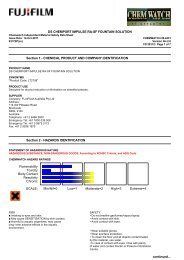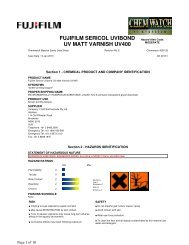Chemwatch MSDS Print - FUJIFILM Australia
Chemwatch MSDS Print - FUJIFILM Australia
Chemwatch MSDS Print - FUJIFILM Australia
Create successful ePaper yourself
Turn your PDF publications into a flip-book with our unique Google optimized e-Paper software.
Fujifilm CP-49HV II PC P1-R<br />
<strong>Chemwatch</strong> Material Safety Data Sheet<br />
Issue Date: 27-Feb-2012 CHEMWATCH 26-6393<br />
9317SP<br />
Version No:2.0<br />
Page 1 of 9<br />
Section 1 - CHEMICAL PRODUCT AND COMPANY IDENTIFICATION<br />
PRODUCT NAME<br />
Fujifilm CP-49HV II PC P1-R<br />
PROPER SHIPPING NAME<br />
POTASSIUM HYDROXIDE SOLUTION<br />
PRODUCT NUMBERS<br />
61125<br />
PRODUCT USE<br />
For processing of photographic colour paper.<br />
SUPPLIER<br />
Company: <strong>FUJIFILM</strong> <strong>Australia</strong> Pty Ltd<br />
Address:<br />
114 Old Pittwater Road<br />
Brookvale<br />
NSW, 2100<br />
<strong>Australia</strong><br />
Telephone: +61 2 9466 2600<br />
Emergency Tel:+61 1800 039 008<br />
Emergency Tel:+61 3 9573 3112<br />
Fax: +61 2 9938 1975<br />
Section 2 - HAZARDS IDENTIFICATION<br />
STATEMENT OF HAZARDOUS NATURE<br />
HAZARDOUS SUBSTANCE. DANGEROUS GOODS. According to the Criteria of NOHSC, and the ADG Code.<br />
CHEMWATCH HAZARD RATINGS<br />
Flammability<br />
Toxicity<br />
Body Contact<br />
Reactivity<br />
Chronic<br />
SCALE: Min/Nil=0 Low=1 Moderate=2 High=3 Extreme=4<br />
RISK<br />
■ Irritating to eyes and skin.<br />
■ May cause SENSITISATION by<br />
skin contact.<br />
■ Toxic to soil organisms.<br />
SAFETY<br />
• Do not breathe gas/fumes/vapour/spray.<br />
• Avoid contact with skin.<br />
• Avoid contact with eyes.<br />
• Wear suitable gloves.<br />
• Wear eye/face protection.<br />
continued...
Fujifilm CP-49HV II PC P1-R<br />
<strong>Chemwatch</strong> Material Safety Data Sheet<br />
Issue Date: 27-Feb-2012 CHEMWATCH 26-6393<br />
9317SP<br />
Version No:2.0<br />
Page 2 of 9<br />
Section 2 - HAZARDS IDENTIFICATION<br />
• To clean the floor and all objects contaminated by this<br />
material, use water.<br />
• In case of contact with eyes, rinse with plenty of water and<br />
contact Doctor or Poisons Information Centre.<br />
• If swallowed, IMMEDIATELY contact Doctor or Poisons Information<br />
Centre. (show this container or label).<br />
• This material and its container must be disposed of as hazardous<br />
waste.<br />
Section 3 - COMPOSITION / INFORMATION ON INGREDIENTS<br />
NAME CAS RN %<br />
potassium carbonate 584-08-7 5-10<br />
EDTA tetrapotassium salt 5964-35-2 1-5<br />
N- [2- (4- amino- N- ethyl- m- 92-09-1 1-5<br />
toluidino)ethyl]methanesulfonamide<br />
potassium hydroxide 1310-58-3 0.5-1.5<br />
other non hazardous ingredients >60<br />
Section 4 - FIRST AID MEASURES<br />
SWALLOWED<br />
• Immediately give a glass of water.<br />
• First aid is not generally required. If in doubt, contact a Poisons Information Centre or a doctor.<br />
EYE<br />
■ If this product comes in contact with the eyes:<br />
• Wash out immediately with fresh running water.<br />
• Ensure complete irrigation of the eye by keeping eyelids apart and away from eye and moving the eyelids by occasionally lifting<br />
the upper and lower lids.<br />
• Seek medical attention without delay; if pain persists or recurs seek medical attention.<br />
• Removal of contact lenses after an eye injury should only be undertaken by skilled personnel.<br />
SKIN<br />
■ If skin contact occurs:<br />
• Immediately remove all contaminated clothing, including footwear.<br />
• Flush skin and hair with running water (and soap if available).<br />
• Seek medical attention in event of irritation.<br />
INHALED<br />
• If fumes, aerosols or combustion products are inhaled remove from contaminated area.<br />
• Other measures are usually unnecessary.<br />
• Inhalation of vapours or aerosols (mists, fumes) may cause lung oedema.<br />
• Corrosive substances may cause lung damage (e.g. lung oedema, fluid in the lungs).<br />
• As this reaction may be delayed up to 24 hours after exposure, affected individuals need complete rest (preferably in semirecumbent<br />
posture) and must be kept under medical observation even if no symptoms are (yet) manifested.<br />
• Before any such manifestation, the administration of a spray containing a dexamethasone derivative or beclomethasone derivative<br />
may be considered.<br />
NOTES TO PHYSICIAN<br />
■ Treat symptomatically.<br />
For acute or short-term repeated exposures to highly alkaline materials:<br />
• Respiratory stress is uncommon but present occasionally because of soft tissue edema.<br />
• Unless endotracheal intubation can be accomplished under direct vision, cricothyroidotomy or tracheotomy may be necessary.<br />
• Oxygen is given as indicated.<br />
• The presence of shock suggests perforation and mandates an intravenous line and fluid administration.<br />
continued...
Fujifilm CP-49HV II PC P1-R<br />
<strong>Chemwatch</strong> Material Safety Data Sheet<br />
Issue Date: 27-Feb-2012 CHEMWATCH 26-6393<br />
9317SP<br />
Version No:2.0<br />
Page 3 of 9<br />
Section 5 - FIRE FIGHTING MEASURES<br />
EXTINGUISHING MEDIA<br />
■ The product contains a substantial proportion of water, therefore there are no restrictions on the type of extinguishing media<br />
which may be used. Choice of extinguishing media should take into account surrounding areas.<br />
Though the material is non-combustible, evaporation of water from the mixture, caused by the heat of nearby fire, may produce<br />
floating layers of combustible substances.<br />
In such an event consider:<br />
• foam.<br />
FIRE FIGHTING<br />
• Alert Fire Brigade and tell them location and nature of hazard.<br />
• Wear full body protective clothing with breathing apparatus.<br />
• Prevent, by any means available, spillage from entering drains or water course.<br />
• Use fire fighting procedures suitable for surrounding area.<br />
FIRE/EXPLOSION HAZARD<br />
• The material is not readily combustible under normal conditions.<br />
• However, it will break down under fire conditions and the organic component may burn.<br />
• Not considered to be a significant fire risk.<br />
• Heat may cause expansion or decomposition with violent rupture of containers.<br />
Decomposes on heating and produces toxic fumes of: carbon dioxide (CO2), nitrogen oxides (NOx), sulfur oxides (SOx), other<br />
pyrolysis products typical of burning organic material.<br />
May emit corrosive fumes.<br />
FIRE INCOMPATIBILITY<br />
■ None known.<br />
HAZCHEM<br />
2R<br />
Section 6 - ACCIDENTAL RELEASE MEASURES<br />
MINOR SPILLS<br />
■ Environmental hazard - contain spillage.<br />
• Drains for storage or use areas should have retention basins for pH adjustments and dilution of spills before discharge or<br />
disposal of material.<br />
• Check regularly for spills and leaks.<br />
• Clean up all spills immediately.<br />
• Avoid breathing vapours and contact with skin and eyes.<br />
• Control personal contact with the substance, by using protective equipment.<br />
• Contain and absorb spill with sand, earth, inert material or vermiculite.<br />
MAJOR SPILLS<br />
■ Environmental hazard - contain spillage.<br />
• Clear area of personnel and move upwind.<br />
• Alert Fire Brigade and tell them location and nature of hazard.<br />
• Wear full body protective clothing with breathing apparatus.<br />
• Prevent, by any means available, spillage from entering drains or water course.<br />
Personal Protective Equipment advice is contained in Section 8 of the <strong>MSDS</strong>.<br />
Section 7 - HANDLING AND STORAGE<br />
PROCEDURE FOR HANDLING<br />
• DO NOT allow clothing wet with material to stay in contact with skin.<br />
• Avoid all personal contact, including inhalation.<br />
• Wear protective clothing when risk of exposure occurs.<br />
• Use in a well-ventilated area.<br />
• Avoid contact with moisture.<br />
continued...
Fujifilm CP-49HV II PC P1-R<br />
<strong>Chemwatch</strong> Material Safety Data Sheet<br />
Issue Date: 27-Feb-2012 CHEMWATCH 26-6393<br />
9317SP<br />
Version No:2.0<br />
Page 4 of 9<br />
Section 7 - HANDLING AND STORAGE<br />
SUITABLE CONTAINER<br />
• Lined metal can, lined metal pail/ can.<br />
• Plastic pail.<br />
• Polyliner drum.<br />
• Packing as recommended by manufacturer.<br />
For low viscosity materials<br />
• Drums and jerricans must be of the non-removable head type.<br />
• Where a can is to be used as an inner package, the can must have a screwed enclosure.
Fujifilm CP-49HV II PC P1-R<br />
<strong>Chemwatch</strong> Material Safety Data Sheet<br />
Issue Date: 27-Feb-2012 CHEMWATCH 26-6393<br />
9317SP<br />
Version No:2.0<br />
Page 5 of 9<br />
Section 8 - EXPOSURE CONTROLS / PERSONAL PROTECTION<br />
PERSONAL PROTECTION<br />
RESPIRATOR<br />
•Type A-P Filter of sufficient capacity. (AS/NZS 1716 & 1715, EN 143:2000 & 149:2001, ANSI Z88 or national equivalent)<br />
EYE<br />
• Safety glasses with side shields.<br />
• Chemical goggles.<br />
• Contact lenses may pose a special hazard; soft contact lenses may absorb and concentrate irritants. A written policy document,<br />
describing the wearing of lens or restrictions on use, should be created for each workplace or task. This should include a<br />
review of lens absorption and adsorption for the class of chemicals in use and an account of injury experience. Medical and<br />
first-aid personnel should be trained in their removal and suitable equipment should be readily available. In the event of<br />
chemical exposure, begin eye irrigation immediately and remove contact lens as soon as practicable. Lens should be removed at<br />
the first signs of eye redness or irritation - lens should be removed in a clean environment only after workers have washed<br />
hands thoroughly. [CDC NIOSH Current Intelligence Bulletin 59], [AS/NZS 1336 or national equivalent].<br />
HANDS/FEET<br />
• Wear chemical protective gloves, eg. PVC.<br />
• Wear safety footwear or safety gumboots, eg. Rubber.<br />
NOTE:<br />
• The material may produce skin sensitisation in predisposed individuals. Care must be taken, when removing gloves and other<br />
protective equipment, to avoid all possible skin contact.<br />
• Contaminated leather items, such as shoes, belts and watch-bands should be removed and destroyed.<br />
Suitability and durability of glove type is dependent on usage. Important factors in the selection of gloves include:<br />
• frequency and duration of contact,<br />
• chemical resistance of glove material,<br />
• glove thickness and<br />
• dexterity.<br />
OTHER<br />
• Overalls.<br />
• PVC Apron.<br />
• PVC protective suit may be required if exposure severe.<br />
• Eyewash unit.<br />
ENGINEERING CONTROLS<br />
■ Engineering controls are used to remove a hazard or place a barrier between the worker and the hazard. Well-designed<br />
engineering controls can be highly effective in protecting workers and will typically be independent of worker interactions to<br />
provide this high level of protection.<br />
The basic types of engineering controls are:<br />
Process controls which involve changing the way a job activity or process is done to reduce the risk.<br />
Enclosure and/or isolation of emission source which keeps a selected hazard "physically" away from the worker and ventilation<br />
that strategically "adds" and "removes" air in the work environment.<br />
Section 9 - PHYSICAL AND CHEMICAL PROPERTIES<br />
APPEARANCE<br />
Amber yellow alkaline liquid; mixes with water.<br />
PHYSICAL PROPERTIES<br />
Liquid.<br />
Mixes with water.<br />
Corrosive.<br />
Alkaline.<br />
State Liquid Molecular Weight Not Applicable<br />
Melting Range (°C) Not Available Viscosity Not Available<br />
Boiling Range (°C) >100 Solubility in water (g/L) Miscible<br />
Flash Point (°C) Not Applicable pH (1% solution) Not Available<br />
Decomposition Temp (°C) Not Available pH (as supplied) 13.4<br />
Autoignition Temp (°C) Not Applicable Vapour Pressure (kPa) ~2.0 @ 20C<br />
continued...
Fujifilm CP-49HV II PC P1-R<br />
<strong>Chemwatch</strong> Material Safety Data Sheet<br />
Issue Date: 27-Feb-2012 CHEMWATCH 26-6393<br />
9317SP<br />
Version No:2.0<br />
Page 6 of 9<br />
Section 9 - PHYSICAL AND CHEMICAL PROPERTIES<br />
Upper Explosive Limit (%) Not Applicable Specific Gravity (water=1) 1.18<br />
Lower Explosive Limit (%) Not Applicable Relative Vapour Density Not Applicable<br />
(air=1)<br />
Volatile Component (%vol) Not Available Evaporation Rate Not Available<br />
Section 10 - STABILITY AND REACTIVITY<br />
CONDITIONS CONTRIBUTING TO INSTABILITY<br />
• Presence of incompatible materials.<br />
• Product is considered stable.<br />
• Hazardous polymerisation will not occur.<br />
For incompatible materials - refer to Section 7 - Handling and Storage.<br />
Section 11 - TOXICOLOGICAL INFORMATION<br />
POTENTIAL HEALTH EFFECTS<br />
ACUTE HEALTH EFFECTS<br />
SWALLOWED<br />
■ The material has NOT been classified by EC Directives or other classification systems as "harmful by ingestion". This is<br />
because of the lack of corroborating animal or human evidence. The material may still be damaging to the health of the individual,<br />
following ingestion, especially where pre-existing organ (eg. liver, kidney) damage is evident. Present definitions of harmful or<br />
toxic substances are generally based on doses producing mortality rather than those producing morbidity (disease, ill-health).<br />
Gastrointestinal tract discomfort may produce nausea and vomiting. In an occupational setting however, ingestion of insignificant<br />
quantities is not thought to be cause for concern.<br />
EYE<br />
■ This material can cause eye irritation and damage in some persons.<br />
SKIN<br />
■ This material can cause inflammation of the skin oncontact in some persons.<br />
The material may accentuate any pre-existing dermatitis condition.<br />
Entry into the blood-stream, through, for example, cuts, abrasions or lesions, may produce systemic injury with harmful effects.<br />
Examine the skin prior to the use of the material and ensure that any external damage is suitably protected.<br />
INHALED<br />
■ Not normally a hazard due to non-volatile nature of product.<br />
Inhaling corrosive bases may irritate the respiratory tract. Symptoms include cough, choking, pain and damage to the mucous<br />
membrane. In severe cases, lung swelling may develop, sometimes after a delay of hours to days. There may be low blood pressure,<br />
a weak and rapid pulse, and crackling sounds.<br />
CHRONIC HEALTH EFFECTS<br />
■ Skin contact with the material is more likely to cause a sensitisation reaction in some persons compared to the general<br />
population.<br />
Substance accumulation, in the human body, may occur and may cause some concern following repeated or long-term occupational<br />
exposure.<br />
There is some evidence that inhaling this product is more likely to cause a sensitisation reaction in some persons compared to<br />
the general population.<br />
Prolonged oral treatment with sulfonamides has caused nausea, vomiting, diarrhoea, abdominal pain, loss of appetite, inflammation<br />
of the mouth cavity, impaired folic acid absorption, exacerbation of porphyria, acidosis, liver damage with impaired blood<br />
clotting, jaundice and inflammation of the pancreas. Effects on the kidney include blood and crystals in the urine, painful and<br />
frequent urination or lack of urine with nitrogen retention. Nervous system symptoms include headache, drowsiness, trouble<br />
sleeping, dizziness, ringing in the ears, hearing loss, depression, hallucinations, inco-ordination, paralysis of muscles,<br />
numbness in the extremities, spinal cord damage and inflammation, convulsions and unconsciousness. Effects on the blood include a<br />
change in blood cell distribution with loss of white blood cells and platelets, and anaemia, which Africans seem to be more prone<br />
to developing than Europeans. Cyanosis can occur owing to complexes being formed by haemoglobin. Eye effects include inflamed<br />
cornea and conjunctiva with eyelid swelling and in severe cases, fear of the light. Allergies and cross-sensitivity is common,<br />
and can cause itches, wheals and sometimes a severe red rash with blisters that is often fatal. This class of drugs can scar the<br />
cornea and conjunctiva, cause swelling around the eyes, painful and inflamed joints, reduced sperm counts, pneumonia, fever,<br />
chills, hair loss, inflammation of vessels, lupus, reduced lung function, infertility, hypothyroidism and goitre, and increased<br />
urinary output. More seriously, the lungs may become permanently scarred and there may be irreversible damage to the nervous<br />
system and muscles. Inflammation of the skin has occurred after the drug is ingested and has travelled through the bloodstream.<br />
Skin effects often occur when there has been exposure in conjunction with UV light. Clothed areas are initially less likely to be<br />
affected but may be in later stages. Rarely there may be persistence of inflammation on light contact even after the drug has<br />
continued...
Fujifilm CP-49HV II PC P1-R<br />
<strong>Chemwatch</strong> Material Safety Data Sheet<br />
Issue Date: 27-Feb-2012 CHEMWATCH 26-6393<br />
9317SP<br />
Version No:2.0<br />
Page 7 of 9<br />
Section 11 - TOXICOLOGICAL INFORMATION<br />
been removed.<br />
Repeated exposure to hydroxylamine and derivatives may result in respiratory sensitisation with asthma-like symptoms.<br />
TOXICITY AND IRRITATION<br />
■ Contact allergies quickly manifest themselves as contact eczema, more rarely as urticaria or Quincke's oedema. The pathogenesis<br />
of contact eczema involves a cell-mediated (T lymphocytes) immune reaction of the delayed type. Other allergic skin reactions,<br />
e.g. contact urticaria, involve antibody-mediated immune reactions. The significance of the contact allergen is not simply<br />
determined by its sensitisation potential: the distribution of the substance and the opportunities for contact with it are<br />
equally important. A weakly sensitising substance which is widely distributed can be a more important allergen than one with<br />
stronger sensitising potential with which few individuals come into contact. From a clinical point of view, substances are<br />
noteworthy if they produce an allergic test reaction in more than 1% of the persons tested.<br />
No significant acute toxicological data identified in literature search.<br />
Asthma-like symptoms may continue for months or even years after exposure to the material ceases. This may be due to a nonallergenic<br />
condition known as reactive airways dysfunction syndrome (RADS) which can occur following exposure to high levels of<br />
highly irritating compound.<br />
Section 12 - ECOLOGICAL INFORMATION<br />
Toxic to soil organisms.<br />
This material and its container must be disposed of as hazardous waste.<br />
Ecotoxicity<br />
Ingredient Persistence: Persistence: Air Bioaccumulation Mobility<br />
Water/Soil<br />
potassium carbonate No Data No Data<br />
Available<br />
Available<br />
EDTA tetrapotassium salt No Data No Data<br />
Available<br />
Available<br />
N- [2- (4- amino- N- ethyl- m- HIGH No Data LOW MED<br />
toluidino)ethyl]methanesulfonami<br />
Available<br />
de<br />
potassium hydroxide No Data No Data LOW<br />
Available<br />
Available<br />
Section 13 - DISPOSAL CONSIDERATIONS<br />
• Containers may still present a chemical hazard/ danger when empty.<br />
• Return to supplier for reuse/ recycling if possible.<br />
Otherwise:<br />
• If container can not be cleaned sufficiently well to ensure that residuals do not remain or if the container cannot be used to<br />
store the same product, then puncture containers, to prevent re-use, and bury at an authorised landfill.<br />
• Where possible retain label warnings and <strong>MSDS</strong> and observe all notices pertaining to the product.<br />
Legislation addressing waste disposal requirements may differ by country, state and/ or territory. Each user must refer to laws<br />
operating in their area.<br />
A Hierarchy of Controls seems to be common - the user should investigate:<br />
• Reduction.<br />
• DO NOT allow wash water from cleaning or process equipment to enter drains.<br />
• It may be necessary to collect all wash water for treatment before disposal.<br />
• In all cases disposal to sewer may be subject to local laws and regulations and these should be considered first.<br />
• Where in doubt contact the responsible authority.<br />
• Recycle wherever possible.<br />
• Consult manufacturer for recycling options or consult local or regional waste management authority for disposal if no suitable<br />
treatment or disposal facility can be identified.<br />
• Treat and neutralise at an approved treatment plant.<br />
• Treatment should involve: Neutralisation with suitable dilute acid followed by: burial in a land-fill specifically licenced to<br />
accept chemical and / or pharmaceutical wastes or Incineration in a licenced apparatus (after admixture with suitable<br />
combustible material).<br />
continued...
Fujifilm CP-49HV II PC P1-R<br />
<strong>Chemwatch</strong> Material Safety Data Sheet<br />
Issue Date: 27-Feb-2012 CHEMWATCH 26-6393<br />
9317SP<br />
Version No:2.0<br />
Page 8 of 9<br />
Section 14 - TRANSPORTATION INFORMATION<br />
Labels Required: CORROSIVE<br />
HAZCHEM:<br />
2R (ADG7)<br />
Land Transport UNDG:<br />
Class or division: 8 Subsidiary risk: None<br />
UN No.: 1814 UN packing group: III<br />
Shipping Name:POTASSIUM HYDROXIDE SOLUTION<br />
Air Transport IATA:<br />
ICAO/IATA Class: 8 ICAO/IATA Subrisk: None<br />
UN/ID Number: 1814 Packing Group: III<br />
Special provisions:<br />
A3<br />
Cargo Only<br />
Packing Instructions: 856 Maximum Qty/Pack: 60 L<br />
Passenger and Cargo<br />
Passenger and Cargo<br />
Packing Instructions: 852 Maximum Qty/Pack: 5 L<br />
Passenger and Cargo Limited Quantity<br />
Passenger and Cargo Limited Quantity<br />
Packing Instructions: Y841 Maximum Qty/Pack: 1 L<br />
Shipping name:POTASSIUM HYDROXIDE SOLUTION<br />
Maritime Transport IMDG:<br />
IMDG Class: 8 IMDG Subrisk: None<br />
UN Number: 1814 Packing Group: III<br />
EMS Number: F-A,S-B Special provisions: 223<br />
Limited Quantities: 5 L<br />
Shipping name:POTASSIUM HYDROXIDE SOLUTION<br />
Section 15 - REGULATORY INFORMATION<br />
POISONS SCHEDULE<br />
S5<br />
REGULATIONS<br />
Regulations for ingredients<br />
potassium carbonate (CAS: 584-08-7, 6381-79-9) is found on the following regulatory lists;<br />
"<strong>Australia</strong> - Victoria Occupational Health and Safety Regulations - Schedule 9: Materials at Major Hazard Facilities (And Their<br />
Threshold Quantity) Table 2", "<strong>Australia</strong> High Volume Industrial Chemical List (HVICL)", "<strong>Australia</strong> Inventory of Chemical<br />
Substances (AICS)", "<strong>Australia</strong> National Pollutant Inventory", "<strong>Australia</strong> Standard for the Uniform Scheduling of Medicines and<br />
Poisons (SUSMP) - Appendix C", "<strong>Australia</strong> Standard for the Uniform Scheduling of Medicines and Poisons (SUSMP) - Appendix E (Part<br />
2)", "<strong>Australia</strong> Standard for the Uniform Scheduling of Medicines and Poisons (SUSMP) - Appendix F (Part 3)", "<strong>Australia</strong> Standard<br />
for the Uniform Scheduling of Medicines and Poisons (SUSMP) - Schedule 5", "<strong>Australia</strong> Standard for the Uniform Scheduling of<br />
Medicines and Poisons (SUSMP) - Schedule 6", "CODEX General Standard for Food Additives (GSFA) - Additives Permitted for Use in<br />
Food in General, Unless Otherwise Specified, in Accordance with GMP", "International Council of Chemical Associations (ICCA) -<br />
High Production Volume List", "OECD List of High Production Volume (HPV) Chemicals"<br />
EDTA tetrapotassium salt (CAS: 5964-35-2) is found on the following regulatory lists;<br />
"<strong>Australia</strong> Inventory of Chemical Substances (AICS)", "<strong>Australia</strong> Standard for the Uniform Scheduling of Medicines and Poisons<br />
(SUSMP) - Schedule 4", "OECD List of High Production Volume (HPV) Chemicals", "OSPAR National List of Candidates for Substitution<br />
– United Kingdom"<br />
N-[2-(4-amino-N-ethyl-m-toluidino)ethyl]methanesulfonamide (CAS: 92-09-1) is found on the<br />
following regulatory lists;<br />
"<strong>Australia</strong> Inventory of Chemical Substances (AICS)", "<strong>Australia</strong> Standard for the Uniform Scheduling of Medicines and Poisons<br />
continued...
Fujifilm CP-49HV II PC P1-R<br />
<strong>Chemwatch</strong> Material Safety Data Sheet<br />
Issue Date: 27-Feb-2012 CHEMWATCH 26-6393<br />
9317SP<br />
Version No:2.0<br />
Page 9 of 9<br />
Section 15 - REGULATORY INFORMATION<br />
(SUSMP) - Schedule 4"<br />
potassium hydroxide (CAS: 1310-58-3) is found on the following regulatory lists;<br />
"<strong>Australia</strong> Exposure Standards", "<strong>Australia</strong> Hazardous Substances", "<strong>Australia</strong> High Volume Industrial Chemical List (HVICL)",<br />
"<strong>Australia</strong> Inventory of Chemical Substances (AICS)", "<strong>Australia</strong> Standard for the Uniform Scheduling of Medicines and Poisons<br />
(SUSMP) - Appendix C", "<strong>Australia</strong> Standard for the Uniform Scheduling of Medicines and Poisons (SUSMP) - Appendix E (Part 2)",<br />
"<strong>Australia</strong> Standard for the Uniform Scheduling of Medicines and Poisons (SUSMP) - Appendix F (Part 3)", "<strong>Australia</strong> Standard for<br />
the Uniform Scheduling of Medicines and Poisons (SUSMP) - Schedule 5", "<strong>Australia</strong> Standard for the Uniform Scheduling of<br />
Medicines and Poisons (SUSMP) - Schedule 6", "CODEX General Standard for Food Additives (GSFA) - Additives Permitted for Use in<br />
Food in General, Unless Otherwise Specified, in Accordance with GMP", "GESAMP/EHS Composite List - GESAMP Hazard Profiles",<br />
"IMO IBC Code Chapter 17: Summary of minimum requirements", "International Council of Chemical Associations (ICCA) - High<br />
Production Volume List", "OECD List of High Production Volume (HPV) Chemicals"<br />
No data for Fujifilm CP-49HV II PC P1-R (CW: 26-6393)<br />
Section 16 - OTHER INFORMATION<br />
Denmark Advisory list for selfclassification of dangerous substances<br />
Substance CAS Suggested codes<br />
N- [2- (4- amino- N- ethyl- m- 92- 09- 1 Xn; R22 R43 N;<br />
toluidino)ethyl]methanesulfonamide R50/53<br />
INGREDIENTS WITH MULTIPLE CAS NUMBERS<br />
Ingredient Name CAS<br />
potassium carbonate 584-08-7, 6381-79-9<br />
■ Classification of the preparation and its individual components has drawn on official and authoritative sources as well as<br />
independent review by the <strong>Chemwatch</strong> Classification committee using available literature references.<br />
A list of reference resources used to assist the committee may be found at:<br />
www.chemwatch.net/references.<br />
■ The (M)SDS is a Hazard Communication tool and should be used to assist in the Risk Assessment. Many factors determine whether<br />
the reported Hazards are Risks in the workplace or other settings.<br />
This document is copyright. Apart from any fair dealing for the purposes of private study, research, review or<br />
criticism, as permitted under the Copyright Act, no part may be reproduced by any process without written<br />
permission from CHEMWATCH. TEL (+61 3) 9572 4700.<br />
Issue Date: 27-Feb-2012<br />
<strong>Print</strong> Date: 7-May-2012<br />
This is the end of the <strong>MSDS</strong>.
Fujifilm CP-49HV II PC P2-R - Part A<br />
<strong>Chemwatch</strong> Material Safety Data Sheet<br />
Issue Date: 15-Apr-2011 CHEMWATCH 26-6394<br />
9317SP<br />
Version No:2.0<br />
Page 1 of 8<br />
Section 1 - CHEMICAL PRODUCT AND COMPANY IDENTIFICATION<br />
PRODUCT NAME<br />
Fujifilm CP-49HV II PC P2-R - Part A<br />
PRODUCT NUMBERS<br />
61125<br />
PRODUCT USE<br />
For processing of photographic colour paper.<br />
SUPPLIER<br />
Company: <strong>FUJIFILM</strong> <strong>Australia</strong> Pty Ltd<br />
Address:<br />
114 Old Pittwater Road<br />
Brookvale<br />
NSW, 2100<br />
<strong>Australia</strong><br />
Telephone: +61 2 9466 2600<br />
Emergency Tel:+61 1800 039 008<br />
Emergency Tel:+61 3 9573 3112<br />
Fax: +61 2 9938 1975<br />
Section 2 - HAZARDS IDENTIFICATION<br />
STATEMENT OF HAZARDOUS NATURE<br />
HAZARDOUS SUBSTANCE. NON-DANGEROUS GOODS. According to the Criteria of NOHSC, and the ADG Code.<br />
CHEMWATCH HAZARD RATINGS<br />
Flammability<br />
Toxicity<br />
Body Contact<br />
Reactivity<br />
Chronic<br />
SCALE: Min/Nil=0 Low=1 Moderate=2 High=3 Extreme=4<br />
RISK<br />
■ Irritating to eyes.<br />
■ May cause SENSITISATION by<br />
skin contact.<br />
SAFETY<br />
• Do not breathe gas/fumes/vapour/spray.<br />
• Avoid contact with skin.<br />
• Avoid contact with eyes.<br />
• Wear eye/face protection.<br />
• To clean the floor and all objects contaminated by this<br />
material, use water.<br />
• In case of contact with eyes, rinse with plenty of water and<br />
contact Doctor or Poisons Information Centre.<br />
continued...
Fujifilm CP-49HV II PC P2-R - Part A<br />
<strong>Chemwatch</strong> Material Safety Data Sheet<br />
Issue Date: 15-Apr-2011 CHEMWATCH 26-6394<br />
9317SP<br />
Version No:2.0<br />
Page 2 of 8<br />
Section 2 - HAZARDS IDENTIFICATION<br />
• If swallowed, IMMEDIATELY contact Doctor or Poisons Information<br />
Centre. (show this container or label).<br />
Section 3 - COMPOSITION / INFORMATION ON INGREDIENTS<br />
NAME CAS RN %<br />
EDTA ferric ammonium salt 21265-50-9 15-30<br />
succinic acid 110-15-6 3-7<br />
ammonium nitrate 6484-52-2 1-5<br />
water 7732-18-5 60-80<br />
Section 4 - FIRST AID MEASURES<br />
SWALLOWED<br />
• If swallowed do NOT induce vomiting.<br />
• If vomiting occurs, lean patient forward or place on left side (head-down position, if possible) to maintain open airway and<br />
prevent aspiration.<br />
• Observe the patient carefully.<br />
• Never give liquid to a person showing signs of being sleepy or with reduced awareness; i.e. becoming unconscious.<br />
EYE<br />
■ If this product comes in contact with the eyes:<br />
• Wash out immediately with fresh running water.<br />
• Ensure complete irrigation of the eye by keeping eyelids apart and away from eye and moving the eyelids by occasionally lifting<br />
the upper and lower lids.<br />
• Seek medical attention without delay; if pain persists or recurs seek medical attention.<br />
• Removal of contact lenses after an eye injury should only be undertaken by skilled personnel.<br />
SKIN<br />
■ If skin contact occurs:<br />
• Immediately remove all contaminated clothing, including footwear.<br />
• Flush skin and hair with running water (and soap if available).<br />
• Seek medical attention in event of irritation.<br />
INHALED<br />
• If fumes, aerosols or combustion products are inhaled remove from contaminated area.<br />
• Other measures are usually unnecessary.<br />
NOTES TO PHYSICIAN<br />
■ Treat symptomatically.<br />
For acute or short term repeated exposures to iron and its derivatives:<br />
• Always treat symptoms rather than history.<br />
• In general, however, toxic doses exceed 20 mg/kg of ingested material (as elemental iron) with lethal doses exceeding 180 mg/kg.<br />
• Control of iron stores depend on variation in absorption rather than excretion. Absorption occurs through aspiration, ingestion<br />
and burned skin.<br />
• Hepatic damage may progress to failure with hypoprothrombinaemia and hypoglycaemia. Hepatorenal syndrome may occur.<br />
Section 5 - FIRE FIGHTING MEASURES<br />
EXTINGUISHING MEDIA<br />
■ The product contains a substantial proportion of water, therefore there are no restrictions on the type of extinguishing media<br />
which may be used. Choice of extinguishing media should take into account surrounding areas.<br />
Though the material is non-combustible, evaporation of water from the mixture, caused by the heat of nearby fire, may produce<br />
floating layers of combustible substances.<br />
In such an event consider:<br />
• foam.<br />
FIRE FIGHTING<br />
• Alert Fire Brigade and tell them location and nature of hazard.<br />
• Wear breathing apparatus plus protective gloves in the event of a fire.<br />
• Prevent, by any means available, spillage from entering drains or water courses.<br />
• Use fire fighting procedures suitable for surrounding area.<br />
continued...
Fujifilm CP-49HV II PC P2-R - Part A<br />
<strong>Chemwatch</strong> Material Safety Data Sheet<br />
Issue Date: 15-Apr-2011 CHEMWATCH 26-6394<br />
9317SP<br />
Version No:2.0<br />
Page 3 of 8<br />
Section 5 - FIRE FIGHTING MEASURES<br />
FIRE/EXPLOSION HAZARD<br />
• The material is not readily combustible under normal conditions.<br />
• However, it will break down under fire conditions and the organic component may burn.<br />
• Not considered to be a significant fire risk.<br />
• Heat may cause expansion or decomposition with violent rupture of containers.<br />
Decomposition may produce toxic fumes of: carbon dioxide (CO2), nitrogen oxides (NOx), other pyrolysis products typical of<br />
burning organic material.<br />
May emit poisonous fumes.<br />
May emit corrosive fumes.<br />
FIRE INCOMPATIBILITY<br />
■ None known.<br />
HAZCHEM<br />
None<br />
Section 6 - ACCIDENTAL RELEASE MEASURES<br />
MINOR SPILLS<br />
• Clean up all spills immediately.<br />
• Avoid breathing vapours and contact with skin and eyes.<br />
• Control personal contact with the substance, by using protective equipment.<br />
• Contain and absorb spill with sand, earth, inert material or vermiculite.<br />
MAJOR SPILLS<br />
■ Moderate hazard.<br />
• Clear area of personnel and move upwind.<br />
• Alert Fire Brigade and tell them location and nature of hazard.<br />
• Wear breathing apparatus plus protective gloves.<br />
• Prevent, by any means available, spillage from entering drains or water course.<br />
Personal Protective Equipment advice is contained in Section 8 of the <strong>MSDS</strong>.<br />
Section 7 - HANDLING AND STORAGE<br />
PROCEDURE FOR HANDLING<br />
• DO NOT allow clothing wet with material to stay in contact with skin.<br />
• Avoid all personal contact, including inhalation.<br />
• Wear protective clothing when risk of exposure occurs.<br />
• Use in a well-ventilated area.<br />
• Prevent concentration in hollows and sumps.<br />
SUITABLE CONTAINER<br />
• Lined metal can, lined metal pail/ can.<br />
• Plastic pail.<br />
• Polyliner drum.<br />
• Packing as recommended by manufacturer.<br />
STORAGE INCOMPATIBILITY<br />
■ Salts of ethylenediaminetetraacetic acid (EDTA):<br />
• should not come into contact with strong oxidisers<br />
• are incompatible with metals such as zinc, aluminum, carbon steel, copper, copper alloys, galvanized metals and nickel.<br />
• in contact with metals, such as aluminum, may generate flammable hydrogen gas<br />
• in contact with bases, may evolve hydrogen and oxygen.<br />
STORAGE REQUIREMENTS<br />
• Store in original containers.<br />
• Keep containers securely sealed.<br />
• Store in a cool, dry, well-ventilated area.<br />
• Store away from incompatible materials and foodstuff containers.<br />
continued...
Fujifilm CP-49HV II PC P2-R - Part A<br />
<strong>Chemwatch</strong> Material Safety Data Sheet<br />
Issue Date: 15-Apr-2011 CHEMWATCH 26-6394<br />
9317SP<br />
Version No:2.0<br />
Page 4 of 8<br />
Section 8 - EXPOSURE CONTROLS / PERSONAL PROTECTION<br />
EXPOSURE CONTROLS<br />
Source Material TWA TWA STEL STEL Peak Peak TWA Notes<br />
ppm mg/m³ ppm mg/m³ ppm mg/m³ F/CC<br />
__________ __________ ______ ______ ______ ______ ______ ______ ______ ______<br />
<strong>Australia</strong> (Iron salts, 1<br />
Exposure<br />
soluble (as Fe))<br />
Standards<br />
The following materials had no OELs on our records<br />
• succinic acid: CAS:110- 15- 6<br />
• ammonium nitrate: CAS:6484- 52- 2<br />
• water: CAS:7732- 18- 5<br />
MATERIAL DATA<br />
AMMONIUM NITRATE:<br />
SUCCINIC ACID:<br />
■ It is the goal of the ACGIH (and other Agencies) to recommend TLVs (or their equivalent) for all substances for which there<br />
is evidence of health effects at airborne concentrations encountered in the workplace.<br />
At this time no TLV has been established, even though this material may produce adverse health effects (as evidenced in animal<br />
experiments or clinical experience).<br />
NOTE: The ACGIH occupational exposure standard for Particles Not Otherwise Specified (P.N.O.S) does NOT apply.<br />
EDTA FERRIC AMMONIUM SALT:<br />
<strong>FUJIFILM</strong> CP-49HV II PC P2-R - PART A:<br />
■ The recommended TLV is thought to reduce the likelihood of respiratory irritation and skin irritation from exposure to<br />
aerosols and mists of soluble iron salts.<br />
AMMONIUM NITRATE:<br />
SUCCINIC ACID:<br />
■ Sensory irritants are chemicals that produce temporary and undesirable side-effects on the eyes, nose or throat.<br />
Historically occupational exposure standards for these irritants have been based on observation of workers' responses to various<br />
airborne concentrations.<br />
WATER:<br />
■ No exposure limits set by NOHSC or ACGIH.<br />
PERSONAL PROTECTION<br />
RESPIRATOR<br />
•Type A Filter of sufficient capacity. (AS/NZS 1716 & 1715, EN 143:2000 & 149:2001, ANSI Z88 or national equivalent)<br />
EYE<br />
• Safety glasses with side shields.<br />
• Chemical goggles.<br />
• Contact lenses may pose a special hazard; soft contact lenses may absorb and concentrate irritants. A written policy document,<br />
describing the wearing of lens or restrictions on use, should be created for each workplace or task. This should include a<br />
review of lens absorption and adsorption for the class of chemicals in use and an account of injury experience. Medical and<br />
first-aid personnel should be trained in their removal and suitable equipment should be readily available. In the event of<br />
chemical exposure, begin eye irrigation immediately and remove contact lens as soon as practicable. Lens should be removed at<br />
the first signs of eye redness or irritation - lens should be removed in a clean environment only after workers have washed<br />
hands thoroughly. [CDC NIOSH Current Intelligence Bulletin 59], [AS/NZS 1336 or national equivalent].<br />
HANDS/FEET<br />
• Wear chemical protective gloves, eg. PVC.<br />
• Wear safety footwear or safety gumboots, eg. Rubber.<br />
NOTE:<br />
• The material may produce skin sensitisation in predisposed individuals. Care must be taken, when removing gloves and other<br />
protective equipment, to avoid all possible skin contact.<br />
• Contaminated leather items, such as shoes, belts and watch-bands should be removed and destroyed.<br />
continued...
Fujifilm CP-49HV II PC P2-R - Part A<br />
<strong>Chemwatch</strong> Material Safety Data Sheet<br />
Issue Date: 15-Apr-2011 CHEMWATCH 26-6394<br />
9317SP<br />
Version No:2.0<br />
Page 5 of 8<br />
Section 8 - EXPOSURE CONTROLS / PERSONAL PROTECTION<br />
Suitability and durability of glove type is dependent on usage. Important factors in the selection of gloves include:<br />
• frequency and duration of contact,<br />
• chemical resistance of glove material,<br />
• glove thickness and<br />
• dexterity.<br />
OTHER<br />
• Overalls.<br />
• P.V.C. apron.<br />
• Barrier cream.<br />
• Skin cleansing cream.<br />
ENGINEERING CONTROLS<br />
■ Engineering controls are used to remove a hazard or place a barrier between the worker and the hazard. Well-designed<br />
engineering controls can be highly effective in protecting workers and will typically be independent of worker interactions to<br />
provide this high level of protection.<br />
The basic types of engineering controls are:<br />
Process controls which involve changing the way a job activity or process is done to reduce the risk.<br />
Enclosure and/or isolation of emission source which keeps a selected hazard "physically" away from the worker and ventilation<br />
that strategically "adds" and "removes" air in the work environment.<br />
Section 9 - PHYSICAL AND CHEMICAL PROPERTIES<br />
APPEARANCE<br />
Red brown liquid with a slight ammonia odour; mixes with water.<br />
PHYSICAL PROPERTIES<br />
Liquid.<br />
Mixes with water.<br />
State Liquid Molecular Weight Not Applicable<br />
Melting Range (°C) Not Applicable Viscosity Not Available<br />
Boiling Range (°C) >100 Solubility in water (g/L) Miscible<br />
Flash Point (°C) Not Applicable pH (1% solution) Not Available<br />
Decomposition Temp (°C) Not Available pH (as supplied) 4.5<br />
Autoignition Temp (°C) Not Applicable Vapour Pressure (kPa) Not Available<br />
Upper Explosive Limit (%) Not Applicable Specific Gravity (water=1) 1.15<br />
Lower Explosive Limit (%) Not Applicable Relative Vapour Density Not Available<br />
(air=1)<br />
Volatile Component (%vol) Not Available Evaporation Rate Not Applicable<br />
Section 10 - STABILITY AND REACTIVITY<br />
CONDITIONS CONTRIBUTING TO INSTABILITY<br />
• Presence of incompatible materials.<br />
• Product is considered stable.<br />
• Hazardous polymerisation will not occur.<br />
For incompatible materials - refer to Section 7 - Handling and Storage.<br />
Section 11 - TOXICOLOGICAL INFORMATION<br />
POTENTIAL HEALTH EFFECTS<br />
ACUTE HEALTH EFFECTS<br />
SWALLOWED<br />
■ Accidental ingestion of the material may be damaging to the health of the individual.<br />
Large doses of ammonia or injected ammonium salts may produce diarrhoea and may be sufficiently absorbed to produce increased<br />
production of urine and systemic poisoning. Symptoms include weakening of facial muscle, tremor, anxiety, reduced muscle and limb<br />
control.<br />
continued...
Fujifilm CP-49HV II PC P2-R - Part A<br />
<strong>Chemwatch</strong> Material Safety Data Sheet<br />
Issue Date: 15-Apr-2011 CHEMWATCH 26-6394<br />
9317SP<br />
Version No:2.0<br />
Page 6 of 8<br />
Section 11 - TOXICOLOGICAL INFORMATION<br />
EYE<br />
■ This material can cause eye irritation and damage in some persons.<br />
SKIN<br />
■ The material is not thought to produce adverse health effects or skin irritation following contact (as classified by EC<br />
Directives using animal models). Nevertheless, good hygiene practice requires that exposure be kept to a minimum and that<br />
suitable gloves be used in an occupational setting.<br />
Entry into the blood-stream, through, for example, cuts, abrasions or lesions, may produce systemic injury with harmful effects.<br />
Examine the skin prior to the use of the material and ensure that any external damage is suitably protected.<br />
INHALED<br />
■ The material is not thought to produce either adverse health effects or irritation of the respiratory tract following<br />
inhalation (as classified by EC Directives using animal models). Nevertheless, adverse systemic effects have been produced<br />
following exposure of animals by at least one other route and good hygiene practice requires that exposure be kept to a minimum<br />
and that suitable control measures be used in an occupational setting.<br />
Not normally a hazard due to non-volatile nature of product.<br />
CHRONIC HEALTH EFFECTS<br />
■ Skin contact with the material is more likely to cause a sensitisation reaction in some persons compared to the general<br />
population.<br />
Substance accumulation, in the human body, may occur and may cause some concern following repeated or long-term occupational<br />
exposure.<br />
Chelates are occasionally used in therapies for various forms of poisoning. A systemic reaction known as the "excessive chelation<br />
syndrome" consists mainly of general unwellness, fatigue, thirst, followed by chills and fever. Muscle ache, headache, loss of<br />
appetite, nausea and occasionally increased urinary urgency and frequency may occur, as may cold-like symptoms.<br />
Injection of EDTA and it salts can cause severe kidney damage with tissue death and internal bleeding, bone marrow depression and<br />
critically low levels of calcium.<br />
TOXICITY AND IRRITATION<br />
■ Contact allergies quickly manifest themselves as contact eczema, more rarely as urticaria or Quincke's oedema. The pathogenesis<br />
of contact eczema involves a cell-mediated (T lymphocytes) immune reaction of the delayed type. Other allergic skin reactions,<br />
e.g. contact urticaria, involve antibody-mediated immune reactions. The significance of the contact allergen is not simply<br />
determined by its sensitisation potential: the distribution of the substance and the opportunities for contact with it are<br />
equally important. A weakly sensitising substance which is widely distributed can be a more important allergen than one with<br />
stronger sensitising potential with which few individuals come into contact. From a clinical point of view, substances are<br />
noteworthy if they produce an allergic test reaction in more than 1% of the persons tested.<br />
No significant acute toxicological data identified in literature search.<br />
For ethylenediaminetetraacetic acid (EDTA) and its salts:<br />
EDTA is a strong organic acid (approximately 1000 times stronger than acetic acid). It has a high affinity for alkaline-earth<br />
ions (for example, calcium and magnesium) and heavy-metal ions (for example, lead and mercury).<br />
CARCINOGEN<br />
Nitrate or nitrite International Agency for Group<br />
(ingested) under Research on Cancer (IARC) -<br />
conditions that<br />
Agents Reviewed by the IARC<br />
result in endogenous<br />
Monographs<br />
nitrosation<br />
Section 12 - ECOLOGICAL INFORMATION<br />
No data<br />
Ecotoxicity<br />
Ingredient Persistence: Persistence: Air Bioaccumulation Mobility<br />
Water/Soil<br />
EDTA ferric ammonium salt No Data No Data<br />
Available<br />
Available<br />
succinic acid LOW No Data LOW HIGH<br />
Available<br />
ammonium nitrate No Data No Data LOW<br />
Available<br />
Available<br />
continued...
Fujifilm CP-49HV II PC P2-R - Part A<br />
<strong>Chemwatch</strong> Material Safety Data Sheet<br />
Issue Date: 15-Apr-2011 CHEMWATCH 26-6394<br />
9317SP<br />
Version No:2.0<br />
Page 7 of 8<br />
Section 13 - DISPOSAL CONSIDERATIONS<br />
• Containers may still present a chemical hazard/ danger when empty.<br />
• Return to supplier for reuse/ recycling if possible.<br />
Otherwise:<br />
• If container can not be cleaned sufficiently well to ensure that residuals do not remain or if the container cannot be used to<br />
store the same product, then puncture containers, to prevent re-use, and bury at an authorised landfill.<br />
• Where possible retain label warnings and <strong>MSDS</strong> and observe all notices pertaining to the product.<br />
Legislation addressing waste disposal requirements may differ by country, state and/ or territory. Each user must refer to laws<br />
operating in their area.<br />
A Hierarchy of Controls seems to be common - the user should investigate:<br />
• Reduction.<br />
• DO NOT allow wash water from cleaning or process equipment to enter drains.<br />
• It may be necessary to collect all wash water for treatment before disposal.<br />
• In all cases disposal to sewer may be subject to local laws and regulations and these should be considered first.<br />
• Where in doubt contact the responsible authority.<br />
• Recycle wherever possible.<br />
• Consult manufacturer for recycling options or consult local or regional waste management authority for disposal if no suitable<br />
treatment or disposal facility can be identified.<br />
• Dispose of by: burial in a land-fill specifically licenced to accept chemical and / or pharmaceutical wastes or incineration in<br />
a licenced apparatus (after admixture with suitable combustible material).<br />
• Decontaminate empty containers. Observe all label safeguards until containers are cleaned and destroyed.<br />
Section 14 - TRANSPORTATION INFORMATION<br />
HAZCHEM:<br />
None (ADG7)<br />
NOT REGULATED FOR TRANSPORT OF DANGEROUS GOODS: UN, IATA, IMDG<br />
Section 15 - REGULATORY INFORMATION<br />
POISONS SCHEDULE<br />
None<br />
REGULATIONS<br />
Regulations for ingredients<br />
EDTA ferric ammonium salt (CAS: 21265-50-9) is found on the following regulatory lists;<br />
"<strong>Australia</strong> Exposure Standards", "<strong>Australia</strong> Hazardous Substances", "<strong>Australia</strong> Inventory of Chemical Substances (AICS)", "<strong>Australia</strong><br />
National Pollutant Inventory", "<strong>Australia</strong> Standard for the Uniform Scheduling of Medicines and Poisons (SUSMP) - Schedule 4",<br />
"International Council of Chemical Associations (ICCA) - High Production Volume List", "OECD List of High Production Volume (HPV)<br />
Chemicals"<br />
succinic acid (CAS: 110-15-6) is found on the following regulatory lists;<br />
"<strong>Australia</strong> Inventory of Chemical Substances (AICS)", "<strong>Australia</strong> National Pollutant Inventory", "IMO IBC Code Chapter 17: Summary<br />
of minimum requirements", "International Council of Chemical Associations (ICCA) - High Production Volume List", "International<br />
Fragrance Association (IFRA) Survey: Transparency List", "OECD List of High Production Volume (HPV) Chemicals"<br />
ammonium nitrate (CAS: 6484-52-2) is found on the following regulatory lists;<br />
"<strong>Australia</strong> - <strong>Australia</strong>n Capital Territory - Environment Protection Regulation: Ambient environmental standards (Domestic water<br />
supply - inorganic chemicals)", "<strong>Australia</strong> - <strong>Australia</strong>n Capital Territory - Environment Protection Regulation: Ambient<br />
environmental standards (STOCK - inorganic chemicals)", "<strong>Australia</strong> - <strong>Australia</strong>n Capital Territory - Environment Protection<br />
Regulation: Pollutants entering waterways taken to cause environmental harm (Domestic water supply quality)", "<strong>Australia</strong> -<br />
<strong>Australia</strong>n Capital Territory - Environment Protection Regulation: Pollutants entering waterways taken to cause environmental harm<br />
(STOCK)", "<strong>Australia</strong> - Queensland Hazardous Materials and Prescribed Quantities for Major Hazard Facilities", "<strong>Australia</strong> -<br />
Western <strong>Australia</strong> Hazardous Substances Prohibited for Specified Uses or Methods of Handling", "<strong>Australia</strong> Council of <strong>Australia</strong>n<br />
Governments (COAG) Chemicals of Security Concern", "<strong>Australia</strong> Dangerous Goods Code (ADG Code) - Goods Too Dangerous To Be<br />
Transported", "<strong>Australia</strong> High Volume Industrial Chemical List (HVICL)", "<strong>Australia</strong> Inventory of Chemical Substances (AICS)",<br />
"<strong>Australia</strong> National Pollutant Inventory", "<strong>Australia</strong> Standard for the Uniform Scheduling of Medicines and Poisons (SUSMP) -<br />
Appendix F (Part 3)", "GESAMP/EHS Composite List - GESAMP Hazard Profiles", "IMO IBC Code Chapter 17: Summary of minimum<br />
continued...
Fujifilm CP-49HV II PC P2-R - Part A<br />
<strong>Chemwatch</strong> Material Safety Data Sheet<br />
Issue Date: 15-Apr-2011 CHEMWATCH 26-6394<br />
9317SP<br />
Version No:2.0<br />
Page 8 of 8<br />
Section 15 - REGULATORY INFORMATION<br />
requirements", "IMO MARPOL 73/78 (Annex II) - List of Noxious Liquid Substances Carried in Bulk", "International Agency for<br />
Research on Cancer (IARC) - Agents Reviewed by the IARC Monographs", "International Council of Chemical Associations (ICCA) -<br />
High Production Volume List", "International Maritime Dangerous Goods Requirements (IMDG Code) - Goods Forbidden for Transport",<br />
"OECD List of High Production Volume (HPV) Chemicals"<br />
water (CAS: 7732-18-5) is found on the following regulatory lists;<br />
"<strong>Australia</strong> Inventory of Chemical Substances (AICS)", "IMO IBC Code Chapter 18: List of products to which the Code does not apply",<br />
"International Fragrance Association (IFRA) Survey: Transparency List", "OECD List of High Production Volume (HPV) Chemicals",<br />
"OSPAR National List of Candidates for Substitution – Norway"<br />
No data for Fujifilm CP-49HV II PC P2-R - Part A (CW: 26-6394)<br />
Section 16 - OTHER INFORMATION<br />
■ Classification of the preparation and its individual components has drawn on official and authoritative sources as well as<br />
independent review by the <strong>Chemwatch</strong> Classification committee using available literature references.<br />
A list of reference resources used to assist the committee may be found at:<br />
www.chemwatch.net/references.<br />
■ The (M)SDS is a Hazard Communication tool and should be used to assist in the Risk Assessment. Many factors determine whether<br />
the reported Hazards are Risks in the workplace or other settings.<br />
This document is copyright. Apart from any fair dealing for the purposes of private study, research, review or<br />
criticism, as permitted under the Copyright Act, no part may be reproduced by any process without written<br />
permission from CHEMWATCH. TEL (+61 3) 9572 4700.<br />
Issue Date: 15-Apr-2011<br />
<strong>Print</strong> Date: 7-May-2012<br />
This is the end of the <strong>MSDS</strong>.
Fujifilm CP-49HV II PC P2-R - Part B<br />
<strong>Chemwatch</strong> Material Safety Data Sheet<br />
Issue Date: 15-Apr-2011 CHEMWATCH 26-6395<br />
9317SP<br />
Version No:2.0<br />
Page 1 of 8<br />
Section 1 - CHEMICAL PRODUCT AND COMPANY IDENTIFICATION<br />
PRODUCT NAME<br />
Fujifilm CP-49HV II PC P2-R - Part B<br />
PRODUCT NUMBERS<br />
61125<br />
PRODUCT USE<br />
For processing of photographic colour paper.<br />
SUPPLIER<br />
Company: <strong>FUJIFILM</strong> <strong>Australia</strong> Pty Ltd<br />
Address:<br />
114 Old Pittwater Road<br />
Brookvale<br />
NSW, 2100<br />
<strong>Australia</strong><br />
Telephone: +61 2 9466 2600<br />
Emergency Tel:+61 1800 039 008<br />
Emergency Tel:+61 3 9573 3112<br />
Fax: +61 2 9938 1975<br />
Section 2 - HAZARDS IDENTIFICATION<br />
STATEMENT OF HAZARDOUS NATURE<br />
HAZARDOUS SUBSTANCE. NON-DANGEROUS GOODS. According to the Criteria of NOHSC, and the ADG Code.<br />
CHEMWATCH HAZARD RATINGS<br />
Flammability<br />
Toxicity<br />
Body Contact<br />
Reactivity<br />
Chronic<br />
SCALE: Min/Nil=0 Low=1 Moderate=2 High=3 Extreme=4<br />
RISK<br />
■ Harmful by inhalation.<br />
■ Danger of cumulative effects.<br />
■ Irritating to eyes, respiratory<br />
system and skin.<br />
SAFETY<br />
• Do not breathe gas/fumes/vapour/spray.<br />
• Avoid contact with skin.<br />
• Avoid contact with eyes.<br />
• Wear suitable protective clothing.<br />
• Wear suitable gloves.<br />
• Wear eye/face protection.<br />
• Use only in well ventilated areas.<br />
• Keep container in a well ventilated place.<br />
continued...
Fujifilm CP-49HV II PC P2-R - Part B<br />
<strong>Chemwatch</strong> Material Safety Data Sheet<br />
Issue Date: 15-Apr-2011 CHEMWATCH 26-6395<br />
9317SP<br />
Version No:2.0<br />
Page 2 of 8<br />
Section 2 - HAZARDS IDENTIFICATION<br />
• To clean the floor and all objects contaminated by this<br />
material, use water.<br />
• Keep container tightly closed.<br />
• Keep away from food, drink and animal feeding stuffs.<br />
• In case of contact with eyes, rinse with plenty of water and<br />
contact Doctor or Poisons Information Centre.<br />
• If swallowed, IMMEDIATELY contact Doctor or Poisons<br />
Information Centre. (show this container or label).<br />
Section 3 - COMPOSITION / INFORMATION ON INGREDIENTS<br />
NAME CAS RN %<br />
diammonium thiosulfate 7783-18-8 20-40<br />
ammonium bisulfite 10192-30-0 10-20<br />
water 7732-18-5 40-60<br />
Section 4 - FIRST AID MEASURES<br />
SWALLOWED<br />
• If swallowed do NOT induce vomiting.<br />
• If vomiting occurs, lean patient forward or place on left side (head-down position, if possible) to maintain open airway and<br />
prevent aspiration.<br />
• Observe the patient carefully.<br />
• Never give liquid to a person showing signs of being sleepy or with reduced awareness; i.e. becoming unconscious.<br />
EYE<br />
■ If this product comes in contact with the eyes:<br />
• Immediately hold eyelids apart and flush the eye continuously with running water.<br />
• Ensure complete irrigation of the eye by keeping eyelids apart and away from eye and moving the eyelids by occasionally lifting<br />
the upper and lower lids.<br />
• Continue flushing until advised to stop by the Poisons Information Centre or a doctor, or for at least 15 minutes.<br />
• Transport to hospital or doctor without delay.<br />
SKIN<br />
■ If skin or hair contact occurs:<br />
• Flush skin and hair with running water (and soap if available).<br />
• Seek medical attention in event of irritation.<br />
INHALED<br />
• If fumes or combustion products are inhaled remove from contaminated area.<br />
• Lay patient down. Keep warm and rested.<br />
• Prostheses such as false teeth, which may block airway, should be removed, where possible, prior to initiating first aid<br />
procedures.<br />
• Apply artificial respiration if not breathing, preferably with a demand valve resuscitator, bag-valve mask device, or pocket<br />
mask as trained. Perform CPR if necessary.<br />
• Inhalation of vapours or aerosols (mists, fumes) may cause lung oedema.<br />
• Corrosive substances may cause lung damage (e.g. lung oedema, fluid in the lungs).<br />
• As this reaction may be delayed up to 24 hours after exposure, affected individuals need complete rest (preferably in semirecumbent<br />
posture) and must be kept under medical observation even if no symptoms are (yet) manifested.<br />
• Before any such manifestation, the administration of a spray containing a dexamethasone derivative or beclomethasone derivative<br />
may be considered.<br />
NOTES TO PHYSICIAN<br />
■ Treat symptomatically.<br />
Depending on the degree of exposure, periodic medical examination is indicated. The symptoms of lung oedema often do not manifest<br />
until a few hours have passed and they are aggravated by physical effort.<br />
continued...
Fujifilm CP-49HV II PC P2-R - Part B<br />
<strong>Chemwatch</strong> Material Safety Data Sheet<br />
Issue Date: 15-Apr-2011 CHEMWATCH 26-6395<br />
9317SP<br />
Version No:2.0<br />
Page 3 of 8<br />
Section 5 - FIRE FIGHTING MEASURES<br />
EXTINGUISHING MEDIA<br />
■ The product contains a substantial proportion of water, therefore there are no restrictions on the type of extinguishing media<br />
which may be used. Choice of extinguishing media should take into account surrounding areas.<br />
Though the material is non-combustible, evaporation of water from the mixture, caused by the heat of nearby fire, may produce<br />
floating layers of combustible substances.<br />
In such an event consider:<br />
• foam.<br />
FIRE FIGHTING<br />
• Alert Fire Brigade and tell them location and nature of hazard.<br />
• Wear breathing apparatus plus protective gloves in the event of a fire.<br />
• Prevent, by any means available, spillage from entering drains or water courses.<br />
• Use fire fighting procedures suitable for surrounding area.<br />
FIRE/EXPLOSION HAZARD<br />
• The material is not readily combustible under normal conditions.<br />
• However, it will break down under fire conditions and the organic component may burn.<br />
• Not considered to be a significant fire risk.<br />
• Heat may cause expansion or decomposition with violent rupture of containers.<br />
Decomposition may produce toxic fumes of: carbon dioxide (CO2), nitrogen oxides (NOx), sulfur oxides (SOx), other pyrolysis<br />
products typical of burning organic material.<br />
May emit poisonous fumes.<br />
May emit corrosive fumes.<br />
FIRE INCOMPATIBILITY<br />
■ None known.<br />
HAZCHEM<br />
None<br />
Section 6 - ACCIDENTAL RELEASE MEASURES<br />
MINOR SPILLS<br />
• Clean up all spills immediately.<br />
• Avoid breathing vapours and contact with skin and eyes.<br />
• Control personal contact with the substance, by using protective equipment.<br />
• Contain and absorb spill with sand, earth, inert material or vermiculite.<br />
MAJOR SPILLS<br />
■ Moderate hazard.<br />
• Clear area of personnel and move upwind.<br />
• Alert Fire Brigade and tell them location and nature of hazard.<br />
• Wear breathing apparatus plus protective gloves.<br />
• Prevent, by any means available, spillage from entering drains or water course.<br />
Personal Protective Equipment advice is contained in Section 8 of the <strong>MSDS</strong>.<br />
Section 7 - HANDLING AND STORAGE<br />
PROCEDURE FOR HANDLING<br />
• DO NOT allow clothing wet with material to stay in contact with skin.<br />
• Avoid all personal contact, including inhalation.<br />
• Wear protective clothing when risk of exposure occurs.<br />
• Use in a well-ventilated area.<br />
• Prevent concentration in hollows and sumps.<br />
SUITABLE CONTAINER<br />
• Lined metal can, lined metal pail/ can.<br />
• Plastic pail.<br />
• Polyliner drum.<br />
continued...
Fujifilm CP-49HV II PC P2-R - Part B<br />
<strong>Chemwatch</strong> Material Safety Data Sheet<br />
Issue Date: 15-Apr-2011 CHEMWATCH 26-6395<br />
9317SP<br />
Version No:2.0<br />
Page 4 of 8<br />
Section 7 - HANDLING AND STORAGE<br />
• Packing as recommended by manufacturer.<br />
STORAGE INCOMPATIBILITY<br />
■ For inorganic thiosulfates<br />
• Avoid storage with acids, metal nitrites, sodium nitrite, halogens and oxidizing agents.<br />
• Forms explosive product with potassium nitrate, sodium nitrate<br />
• Reacts with acids, forming sulfur dioxide<br />
• Incompatible with halogens, lead, silver and mercury salts. iodine.<br />
• Contact with acids produces toxic fumes.<br />
• Incidents involving interaction of active oxidants and reducing agents, either by design or accident, are usually very<br />
energetic and examples of so-called redox reactions.<br />
• Reacts with metals producing flammable / explosive hydrogen gas.<br />
• Avoid strong bases.<br />
Sulfites and hydrosulfites (dithionites) :<br />
• may react explosively with strong oxidising agents.<br />
• react with water or steam to produce corrosive acid solutions and sulfur oxide fumes - aqueous solutions are incompatible with<br />
oxidisers, strong acids, alkalis, ammonia, aliphatic amines, alkanolamines, alkylene oxides, amides, epichlorohydrin, organic<br />
anhydrides, isocyanates, nitromethane, vinyl acetate<br />
• aqueous solutions attack metals in presence of moisture<br />
• generate gaseous sulfur dioxide in contact with oxidising and nonoxidising acids.<br />
Sulfur dioxide:<br />
• reacts with water or steam forming sulfurous acid; reaction may be violent<br />
• reacts with acrolein, alcohols, aluminium powder, alkali metals, amines, bromine, pentafluoride, caustics, caesium, acetylene<br />
carbide, chlorates, chlorine trifluoride, chromium powder, copper or its alloy powders, diethylzinc, fluorine, lead dioxide,<br />
lithium acetylene carbide, metal powders, monolithium acetylide-ammonia, nitryl chloride, potassium acetylene carbide,<br />
potassium acetylide, potassium chlorate, rubidium carbide, silver azide, sodium, sodium acetylide, stannous oxide; reaction may<br />
be violent<br />
• decomposes above 60 deg. C releasing oxides of sulfur<br />
• Incompatible with alkalis, alkylene oxides, ammonia, aliphatic amines, alkanolamines, amides, organic anhydrides, caesium<br />
monoxide, epichlorohydrin, ferrous oxide, halogens, interhalogens, isocyanates, lithium nitrate, manganese, metal acetylides,<br />
metal oxides, perbromyl fluoride, red phosphorus, potassium azide, rubidium acetylide, sodium hydride, sulfuric acid.<br />
STORAGE REQUIREMENTS<br />
• Store in original containers.<br />
• Keep containers securely sealed.<br />
• Store in a cool, dry, well-ventilated area.<br />
• Store away from incompatible materials and foodstuff containers.<br />
Section 8 - EXPOSURE CONTROLS / PERSONAL PROTECTION<br />
EXPOSURE CONTROLS<br />
The following materials had no OELs on our records<br />
• diammonium thiosulfate: CAS:7783- 18- 8<br />
• ammonium bisulfite: CAS:10192- 30- 0<br />
• water: CAS:7732- 18- 5<br />
MATERIAL DATA<br />
AMMONIUM BISULFITE:<br />
<strong>FUJIFILM</strong> CP-49HV II PC P2-R - PART B:<br />
■ Inorganic sulfites, bisulfites and metabisulfites (sodium, potassium and ammonium salts) liberate sulfur dioxide under<br />
certain conditions. Therefore the officially tabled exposure limits for these chemicals normally correspond to the yield of<br />
liberated sulfur dioxide.
Fujifilm CP-49HV II PC P2-R - Part B<br />
<strong>Chemwatch</strong> Material Safety Data Sheet<br />
Issue Date: 15-Apr-2011 CHEMWATCH 26-6395<br />
9317SP<br />
Version No:2.0<br />
Page 5 of 8<br />
Section 8 - EXPOSURE CONTROLS / PERSONAL PROTECTION<br />
WATER:<br />
■ No exposure limits set by NOHSC or ACGIH.<br />
PERSONAL PROTECTION<br />
RESPIRATOR<br />
•Type A Filter of sufficient capacity. (AS/NZS 1716 & 1715, EN 143:2000 & 149:2001, ANSI Z88 or national equivalent)<br />
EYE<br />
• Safety glasses with side shields.<br />
• Chemical goggles.<br />
• Contact lenses may pose a special hazard; soft contact lenses may absorb and concentrate irritants. A written policy document,<br />
describing the wearing of lens or restrictions on use, should be created for each workplace or task. This should include a<br />
review of lens absorption and adsorption for the class of chemicals in use and an account of injury experience. Medical and<br />
first-aid personnel should be trained in their removal and suitable equipment should be readily available. In the event of<br />
chemical exposure, begin eye irrigation immediately and remove contact lens as soon as practicable. Lens should be removed at<br />
the first signs of eye redness or irritation - lens should be removed in a clean environment only after workers have washed<br />
hands thoroughly. [CDC NIOSH Current Intelligence Bulletin 59], [AS/NZS 1336 or national equivalent].<br />
HANDS/FEET<br />
• Wear chemical protective gloves, eg. PVC.<br />
• Wear safety footwear or safety gumboots, eg. Rubber.<br />
Suitability and durability of glove type is dependent on usage. Important factors in the selection of gloves include:<br />
• frequency and duration of contact,<br />
• chemical resistance of glove material,<br />
• glove thickness and<br />
• dexterity.<br />
OTHER<br />
• Overalls.<br />
• P.V.C. apron.<br />
• Barrier cream.<br />
• Skin cleansing cream.<br />
ENGINEERING CONTROLS<br />
■ Engineering controls are used to remove a hazard or place a barrier between the worker and the hazard. Well-designed<br />
engineering controls can be highly effective in protecting workers and will typically be independent of worker interactions to<br />
provide this high level of protection.<br />
The basic types of engineering controls are:<br />
Process controls which involve changing the way a job activity or process is done to reduce the risk.<br />
Enclosure and/or isolation of emission source which keeps a selected hazard "physically" away from the worker and ventilation<br />
that strategically "adds" and "removes" air in the work environment.<br />
Section 9 - PHYSICAL AND CHEMICAL PROPERTIES<br />
APPEARANCE<br />
Pale yellow liquid with a slight ammonia odour; mixes with water.<br />
PHYSICAL PROPERTIES<br />
Liquid.<br />
Mixes with water.<br />
State Liquid Molecular Weight Not Applicable<br />
Melting Range (°C) Not Available Viscosity Not Available<br />
Boiling Range (°C) >100 Solubility in water (g/L) Miscible<br />
Flash Point (°C) Not Applicable pH (1% solution) Not Available<br />
Decomposition Temp (°C) Not Available pH (as supplied) 5.55<br />
Autoignition Temp (°C) Not Applicable Vapour Pressure (kPa) Not Available<br />
Upper Explosive Limit (%) Not Applicable Specific Gravity (water=1) 1.27<br />
continued...
Fujifilm CP-49HV II PC P2-R - Part B<br />
<strong>Chemwatch</strong> Material Safety Data Sheet<br />
Issue Date: 15-Apr-2011 CHEMWATCH 26-6395<br />
9317SP<br />
Version No:2.0<br />
Page 6 of 8<br />
Section 9 - PHYSICAL AND CHEMICAL PROPERTIES<br />
Lower Explosive Limit (%) Not Applicable Relative Vapour Density Not Available<br />
(air=1)<br />
Volatile Component (%vol) Not Available Evaporation Rate Not Available<br />
Section 10 - STABILITY AND REACTIVITY<br />
CONDITIONS CONTRIBUTING TO INSTABILITY<br />
• Presence of incompatible materials.<br />
• Product is considered stable.<br />
• Hazardous polymerisation will not occur.<br />
For incompatible materials - refer to Section 7 - Handling and Storage.<br />
Section 11 - TOXICOLOGICAL INFORMATION<br />
POTENTIAL HEALTH EFFECTS<br />
ACUTE HEALTH EFFECTS<br />
SWALLOWED<br />
■ Accidental ingestion of the material may be damaging to the health of the individual.<br />
Thiosulfate salts are poorly absorbed and stimulate the emptying of thebowel.<br />
Large doses of ammonia or injected ammonium salts may produce diarrhoea and may be sufficiently absorbed to produce increased<br />
production of urine and systemic poisoning. Symptoms include weakening of facial muscle, tremor, anxiety, reduced muscle and limb<br />
control.<br />
EYE<br />
■ If applied to the eyes, this material causes severe eye damage.<br />
SKIN<br />
■ Entry into the blood-stream, through, for example, cuts, abrasions or lesions, may produce systemic injury with harmful<br />
effects. Examine the skin prior to the use of the material and ensure that any external damage is suitably protected.<br />
This material can cause inflammation of the skin oncontact in some persons.<br />
INHALED<br />
■ Inhalation of aerosols (mists, fumes), generated by the material during the course of normal handling, may be harmful.<br />
The material can cause respiratory irritation in some persons. The body's response to such irritation can cause further lung<br />
damage.<br />
CHRONIC HEALTH EFFECTS<br />
■ Substance accumulation, in the human body, is likely and may cause some concern following repeated or long-term occupational<br />
exposure.<br />
There is some evidence that inhaling this product is more likely to cause a sensitisation reaction in some persons compared to<br />
the general population.<br />
Sulfites and bisulfites can cause narrowing of the airways, stomach upset, flushing, low blood pressure, tingling sensation,<br />
itchy wheal, swelling and shock, and asthmatics are especially prone. They induce allergic-like reactions which can occur on<br />
first contact with the material.<br />
Chronic explosure to sulfur dioxide (SO2) particle complexes in polluted air can aggravate chronic disease, such as asthma,<br />
chronic pulmonary disease, and coronary artery disease. It is not clear what is the concentration level required to cause these<br />
effects. Although sulfur dioxide does not cause cancer by itself, it might act as a promotor in tumour growth when there was<br />
simultaneous exposure to arsenic. Animal testing showed that simultaneous exposure to benz(a)pyrene and sulfur dioxide increases<br />
the rate of cancer development compared to exposure to only one of the above substances.<br />
TOXICITY AND IRRITATION<br />
■ No significant acute toxicological data identified in literature search.<br />
Asthma-like symptoms may continue for months or even years after exposure to the material ceases. This may be due to a nonallergenic<br />
condition known as reactive airways dysfunction syndrome (RADS) which can occur following exposure to high levels of<br />
highly irritating compound.<br />
CARCINOGEN<br />
Sulfites International Agency for Group 3<br />
Research on Cancer (IARC) -<br />
Agents Reviewed by the IARC<br />
Monographs<br />
continued...
Fujifilm CP-49HV II PC P2-R - Part B<br />
<strong>Chemwatch</strong> Material Safety Data Sheet<br />
Issue Date: 15-Apr-2011 CHEMWATCH 26-6395<br />
9317SP<br />
Version No:2.0<br />
Page 7 of 8<br />
Section 11 - TOXICOLOGICAL INFORMATION<br />
Section 12 - ECOLOGICAL INFORMATION<br />
No data<br />
Ecotoxicity<br />
Ingredient Persistence: Persistence: Air Bioaccumulation Mobility<br />
Water/Soil<br />
diammonium thiosulfate No Data No Data LOW<br />
Available<br />
Available<br />
ammonium bisulfite No Data No Data<br />
Available<br />
Available<br />
Section 13 - DISPOSAL CONSIDERATIONS<br />
■ Legislation addressing waste disposal requirements may differ by country, state and/ or territory. Each user must refer to<br />
laws operating in their area.<br />
A Hierarchy of Controls seems to be common - the user should investigate:<br />
• Reduction.<br />
• DO NOT allow wash water from cleaning or process equipment to enter drains.<br />
• It may be necessary to collect all wash water for treatment before disposal.<br />
• In all cases disposal to sewer may be subject to local laws and regulations and these should be considered first.<br />
• Where in doubt contact the responsible authority.<br />
• Recycle wherever possible.<br />
• Consult manufacturer for recycling options or consult local or regional waste management authority for disposal if no suitable<br />
treatment or disposal facility can be identified.<br />
• Dispose of by: burial in a land-fill specifically licenced to accept chemical and / or pharmaceutical wastes or incineration in<br />
a licenced apparatus (after admixture with suitable combustible material).<br />
• Decontaminate empty containers. Observe all label safeguards until containers are cleaned and destroyed.<br />
Section 14 - TRANSPORTATION INFORMATION<br />
HAZCHEM:<br />
None (ADG7)<br />
■ Air transport may be forbidden if this material is flammable, corrosive or toxic gases may be released under normal conditions<br />
of transport.<br />
NOT REGULATED FOR TRANSPORT OF DANGEROUS GOODS: UN, IATA, IMDG<br />
Section 15 - REGULATORY INFORMATION<br />
POISONS SCHEDULE<br />
None<br />
REGULATIONS<br />
Fujifilm CP-49HV II PC P2-R - Part B (CAS: ) is found on the following regulatory lists;<br />
"International Agency for Research on Cancer (IARC) - Agents Reviewed by the IARC Monographs"<br />
Regulations for ingredients<br />
diammonium thiosulfate (CAS: 7783-18-8) is found on the following regulatory lists;<br />
"<strong>Australia</strong> Hazardous Substances", "<strong>Australia</strong> High Volume Industrial Chemical List (HVICL)", "<strong>Australia</strong> Inventory of Chemical<br />
Substances (AICS)", "<strong>Australia</strong> National Pollutant Inventory", "GESAMP/EHS Composite List - GESAMP Hazard Profiles", "IMO IBC Code<br />
Chapter 17: Summary of minimum requirements", "International Council of Chemical Associations (ICCA) - High Production Volume<br />
List", "OECD List of High Production Volume (HPV) Chemicals"<br />
continued...
Fujifilm CP-49HV II PC P2-R - Part B<br />
<strong>Chemwatch</strong> Material Safety Data Sheet<br />
Issue Date: 15-Apr-2011 CHEMWATCH 26-6395<br />
9317SP<br />
Version No:2.0<br />
Page 8 of 8<br />
Section 15 - REGULATORY INFORMATION<br />
ammonium bisulfite (CAS: 10192-30-0) is found on the following regulatory lists;<br />
"<strong>Australia</strong> Inventory of Chemical Substances (AICS)", "<strong>Australia</strong> National Pollutant Inventory", "GESAMP/EHS Composite List -<br />
GESAMP Hazard Profiles", "International Agency for Research on Cancer (IARC) - Agents Reviewed by the IARC Monographs", "OECD<br />
List of High Production Volume (HPV) Chemicals"<br />
water (CAS: 7732-18-5) is found on the following regulatory lists;<br />
"<strong>Australia</strong> Inventory of Chemical Substances (AICS)", "IMO IBC Code Chapter 18: List of products to which the Code does not apply",<br />
"International Fragrance Association (IFRA) Survey: Transparency List", "OECD List of High Production Volume (HPV) Chemicals",<br />
"OSPAR National List of Candidates for Substitution – Norway"<br />
Section 16 - OTHER INFORMATION<br />
■ Classification of the preparation and its individual components has drawn on official and authoritative sources as well as<br />
independent review by the <strong>Chemwatch</strong> Classification committee using available literature references.<br />
A list of reference resources used to assist the committee may be found at:<br />
www.chemwatch.net/references.<br />
■ The (M)SDS is a Hazard Communication tool and should be used to assist in the Risk Assessment. Many factors determine whether<br />
the reported Hazards are Risks in the workplace or other settings.<br />
This document is copyright. Apart from any fair dealing for the purposes of private study, research, review or<br />
criticism, as permitted under the Copyright Act, no part may be reproduced by any process without written<br />
permission from CHEMWATCH. TEL (+61 3) 9572 4700.<br />
Issue Date: 15-Apr-2011<br />
<strong>Print</strong> Date: 7-May-2012<br />
This is the end of the <strong>MSDS</strong>.


